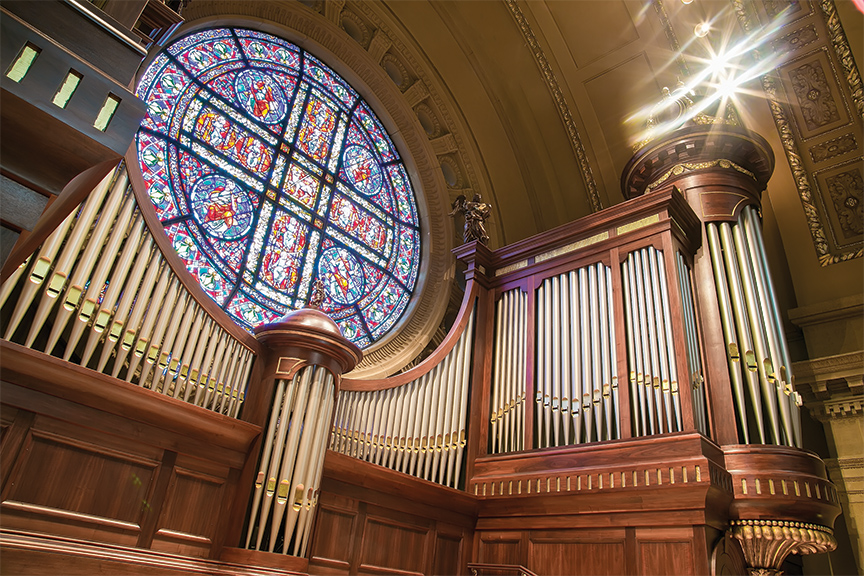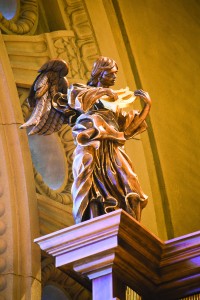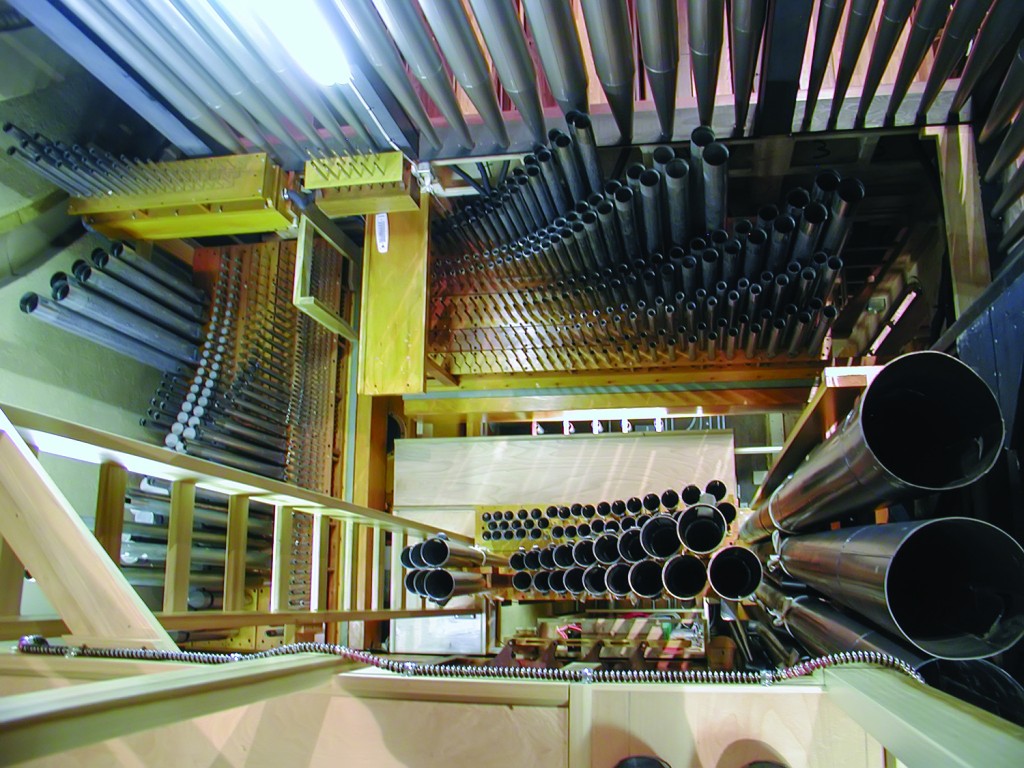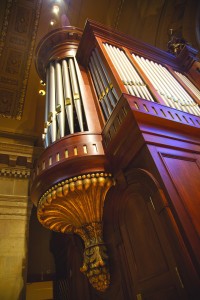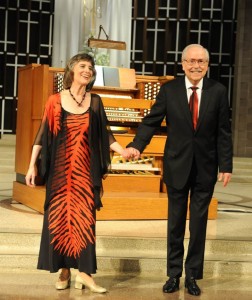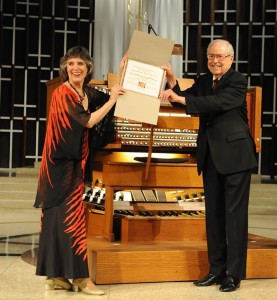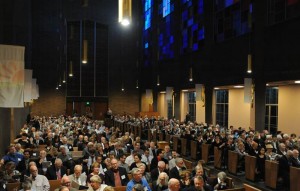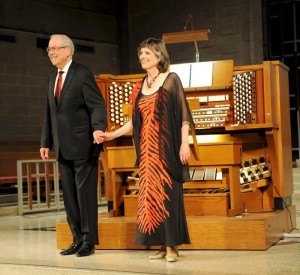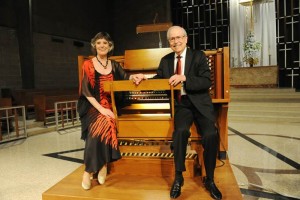Blair School of Music, Vanderbilt University, Nashville, TN
Dobson Pipe Organ Builders, Lake City, IA
By Carl Smith
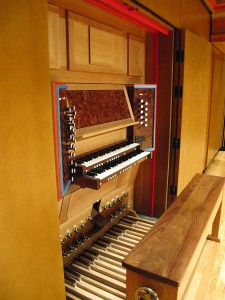 When entering the Blair School’s Steve and Judy Turner Recital Hall, concertgoers do not encounter a hall of memorably imposing architectural grandeur but rather a welcoming space whose warmth and general ambience contribute greatly to the extensive music making that takes place in it each year.
When entering the Blair School’s Steve and Judy Turner Recital Hall, concertgoers do not encounter a hall of memorably imposing architectural grandeur but rather a welcoming space whose warmth and general ambience contribute greatly to the extensive music making that takes place in it each year.
A major factor in the experience of music in Turner Hall (both aurally and visually) is the wood that inconspicuously surrounds the listener yet confronts his or her every glance. When the decision was made to give the new organ’s case a traditional form, it was quickly decided that painting the case would not be suitable in Turner Hall, and that the case would need to be of natural woods, to harmonize with the hall’s various wood tones. From the organ’s elaborate white oak case to its Carpathian elm (burl) music desk and stop jambs to its walnut bench and ebony sharps, the organ is itself something of a symphony in wood—woods whose varied grains are gently analogous to the musical lines that will set them resonating when the organ is played.
As are waves of sound, waves of light are energy and the play of lightwaves on the new Dobson organ produces some memorable images, perhaps most noticeably when they strike the shimmering burnished tin pipes in the case facade. Even when standing quietly in place, these pipes seem full of latent energy, as if waiting for the breath that will make them sing.
Above the facade pipes are laser-cut pipe shades, which have both musical and decorative functions. These polychromed shades are based on the ancient “stems and leaves” pattern, common in architectural embellishment in the West during the Gothic era, yet ultimately of ancient Arabic origin. It is a design that seemed particularly appropriate for an institution devoted to the nurturing of young talent, as is the Blair School.
The surface plane of the shades is solid red, while the carved-out interior surfaces (the leaves) are dark blue, creating a strongly three-dimensional effect that makes every pipe shade, seen from a particular vantage point, subtly different from the others. The hemicylindrical vertical stems are gold-leafed, catching the eye and wicking it upward as do the cylindrical facade pipes beneath them, while the intersecting outlines of some pipe shades (also gilded) describe Gothic arches that reflect the varying lengths of the pipes they encircle.
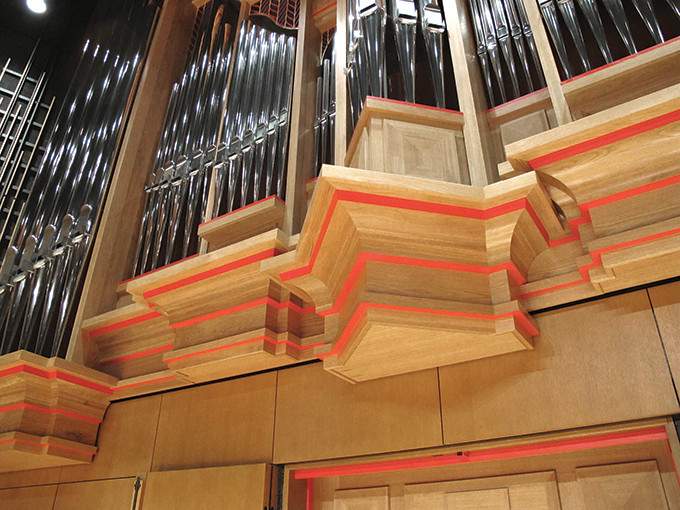 The new organ presents the viewer with an abundance of lines to delight and engage the eye. Perhaps the lilting, side-to-side linear movement of pipe mouths in the facade is first to catch our eye, followed by those same pipes’ stair-step variations in length, traced just above in gold leaf by the pipe shades. Moldings of various sizes and weights (some highlighted in red) ornament the case’s upper and lower reaches, intersect, and sometimes overlap. Inset panels suggest linear motion in both parallel and contrary directions, while the moldings and panels intersect obliquely in the case’s central triangular tower, delineating its centerline.
The new organ presents the viewer with an abundance of lines to delight and engage the eye. Perhaps the lilting, side-to-side linear movement of pipe mouths in the facade is first to catch our eye, followed by those same pipes’ stair-step variations in length, traced just above in gold leaf by the pipe shades. Moldings of various sizes and weights (some highlighted in red) ornament the case’s upper and lower reaches, intersect, and sometimes overlap. Inset panels suggest linear motion in both parallel and contrary directions, while the moldings and panels intersect obliquely in the case’s central triangular tower, delineating its centerline.
The organ’s case is, of course, comprehensively three-dimensional but at even a quick glance we realize that its symmetrical facade consists of multiple sections lying in several different planes, each section having its own clear organization, structural weight, and ornamental detail. With in the harmonious whole, there is a great deal of contrast that one could reasonably liken to rhetorical elements in much of Baroque composition—and, given the prevalence of strong lines of varying weights and lengths and their interplay, and the discrete yet interrelated units that comprise the whole, likening the organ’s appearance to a contrapuntal texture would hardly seem inappropriate. Those inclined to a Schenkerian approach to musical analysis will also find much to admire in the visual organization of the organ’s components, with its multiple planes of structure and varying levels of detail and embellishment.
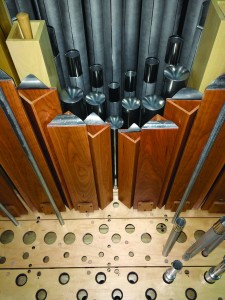
I was no good at high-school algebra, but I loved geometry, with its lines, forms, and planes that seemed to me to be moving about on the page like musical lines and forms, intersecting and overlapping. Little did I know at the time how significant a predictor that was of what would become a lifelong obsession with the movement of line—in music and poetry, in calligraphy, in drawing, and in design—or how it would allow me, much later, to appreciate more fully the beauty of the intersecting and overlapping planes in the new Blair organ’s splendid case.
But geometry has played an unexpected role in its tonal design as well. When I was in high school, I practiced every afternoon at the Presbyterian church across town, where the organ had an intriguing flute stop with wooden pipes that were triangular in design and whose sound was (to my ears) the most interesting on the organ. When we were working on the tonal design for Opus 92, I wanted to find a way to give it a particularly interesting and colorful flute stop on the upper manual—a division whose character is noticeably more Italianate in scaling, in the provision of separate stopknobs for higher-pitched ranks, and in the presence of a full-bodied celeste rank to the 8′ Principal that recalls the old Italian organ’s Voce umana. The short version of what turned out to be a remarkably long story of experimentation with various designs is that our new 4’flute pipes are in fact of a unique, right-triangular design, and they sound splendid. Too, in the interpretation of musical scores, particularly those that come from centuries long past, we often need to resort to reasoning by triangulation to decide what a composer might have meant in the notation of a particular passage. And, of course, whoever plays this instrument does so while seated beneath its triangular central tower.
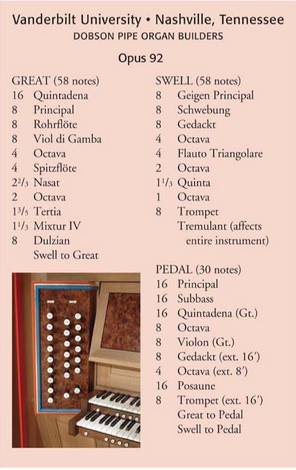 But the circle is also a geometric form, said to be the most perfect, and “rounded” and cyclic structures can be among the most effective ways of organizing musical ideas. Then too, the circle is sometimes used as a metaphor for the course of a life. As the circle of my own life and career begins to close, it is a circumstance of great joy for me to be able to leave to generations of students Blair’s new organ with its wonderful case, rich and imaginative tonal design, and splendid construction—including the unique right-angled flute stop, whose intriguing sound and form may inspire young organists to learn to play it well, perhaps even to write new music for it and the organ’s other 23 rich and beautiful sounds, sounds that individually and in combination offer almost unlimited musical possibilities to players and composers interested in exploring them.
But the circle is also a geometric form, said to be the most perfect, and “rounded” and cyclic structures can be among the most effective ways of organizing musical ideas. Then too, the circle is sometimes used as a metaphor for the course of a life. As the circle of my own life and career begins to close, it is a circumstance of great joy for me to be able to leave to generations of students Blair’s new organ with its wonderful case, rich and imaginative tonal design, and splendid construction—including the unique right-angled flute stop, whose intriguing sound and form may inspire young organists to learn to play it well, perhaps even to write new music for it and the organ’s other 23 rich and beautiful sounds, sounds that individually and in combination offer almost unlimited musical possibilities to players and composers interested in exploring them.
I would like to express my profound gratitude to those whose contributions and efforts have made the organ possible: Cal Turner and Laura Dugas, our generous donors; Mark Wait, dean of the Blair School of Music; Lynn Dobson, John Panning, and all the impressive craftsmen in the Dobson shop who turned our aspirations for a new organ into their Opus 92. Finally, I thank my wife, Carol, whose patient support has made possible most of what I’ve managed to accomplish over the years.
Opus 92’s Unique Perspective
Try as we might, we can never replicate the art of a previous age—inevitably, our effort bears our own unique stamp. Rather than meticulously copying details of historic organs, our new instrument for Blair School of Music frankly admits the impossibility of literal quotation. It seeks to interpret the essentials of several important central German organ traditions from the Baroque era in a way that serves a 21st-century music program.
As in all of its history, the organ’s physical placement greatly determines its character. The location of the previous organ (a rebuilt electric-action instrument), together with the Blair School’s desire to relinquish no stage space, seemed initially to defy the placement of a mechanical-action organ. After thoughtful conversations with Carl Smith and Paul Marshall, Vanderbilt’s project manager, we developed a design that places the manual divisions side by side—Great on the left, Swell on the right—with the Pedal behind. The console is recessed behind new doors in the rear wall of the stage, which, when closed, give no inkling of what lies behind. Suspended mechanical key action is provided, together with electric stop action and a multilevel combination action. This is not a historical solution, but it responds to a present-day situation in a way that is true to tradition.
Tonally, the organ draws inspiration from Saxon and Thuringian organs of the 17th and 18th centuries, the sort of instruments that surrounded and were admired by Johann Sebastian Bach. Because of the new organ’s physical arrangement, there is little spatial distinction between the two manual departments, something that is often pronounced in old instruments whose manual divisions were always placed one over the other or behind the other. To accentuate the tonal differences between our divisions, the Great pipework was made of an alloy rich in lead, while the Swell pipes are largely of tin. Together with appropriate voicing, the effect is striking, as though the Great is an older organ enlarged by a newer, second department. The tuning system, Herbert Anton Kellner’s excellent temperament, is a perfect distillation of Opus 92’s aesthetic intention: Devised in 1977, it is not a historic temperament yet admirably serves both old and new music.
The organ’s appearance is cut from the same philosophical cloth. The shape of the white oak case and the relationship of the various compartments to one another are historically derived, but the architectural treatment is simplified out of respect for the organ’s 20th-century surroundings. With a unique perspective that brings the art of past centuries forward in a lively and engaging way, Opus 92 opens new avenues for organ performance in Nashville. We are confident that both performers and listeners will find the result rewarding.
John Panning, Vice President and Tonal Director, Dobson Pipe Organ Builders
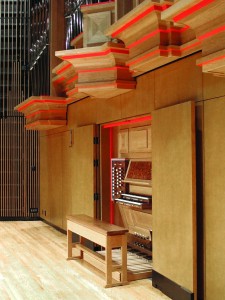
Dobson Pipe Organ Builders
William Ayers
Abraham Batten
Kent Brown
Lynn Dobson
Randy Hausman
Dean Heim
Donny Hobbs
Ben Hoskins
Arthur Middleton
John Panning
Kirk Russell
Bob Savage
Jim Streufurt
John Thieszen
Pat Thieszen
Sally Winter
Randall Wolff
Dean Zenor
Carl Smith has been at the Blair School of Music since 1998, where he is senior lecturer in music theory, composition, organ, and harpsichord. He teaches courses in music theory, 16th-century counterpoint, historical keyboard literature, choral composition, and historical performance traditions. His CD Tudor Organ Music was released in 2006, and his book on Michelangelo Buonarroti’s calligraphic wordplay, What’s in a Name? Michelangelo and the Art of Signature, was published last year.
